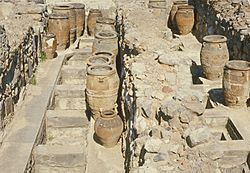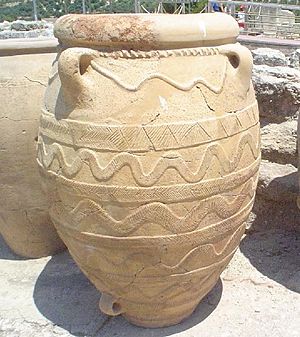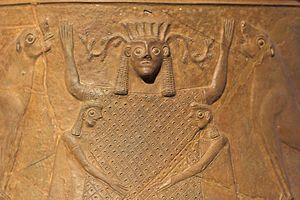Pithos facts for kids
Quick facts for kids Pithos |
|
|---|---|

|
|
 |
|
| Material | Ceramic |
| Size | Approximately the size of a human, some larger, some smaller. |
| Writing | Sometimes inscribed with an identifying mark. |
| Created | Neolithic, Bronze Age, Iron Age |
| Discovered | Most frequently at large administrative centers |
| Present location | Circum-Mediterranean |
| This article contains special characters. Without proper rendering support, you may see question marks, boxes, or other symbols. |
A pithos (pronounced PITH-oss, plural: pithoi) is a very large storage jar. Ancient civilizations around the Mediterranean Sea used these huge containers. They were common during the Neolithic (New Stone Age), Bronze Age, and Iron Age.
Pithoi were mainly used to store large amounts of liquids like wine and olive oil. They also held grains and other food items. Think of them like the big barrels or casks we use today. Different cultures had their own names for them. For example, the Hittites called them harsi-.
Sometimes, old pithoi found new uses. Because of their large size, they were sometimes used as coffins. In ancient burials in places like Mycenae and Crete, people would place bones inside pithoi. The ancient Iberian culture of El Argar also used pithoi for burials.
Contents
What is a Pithos?
Pithoi were typically made of ceramic, which is a type of pottery. They were often as tall as a person, or even taller. They usually had a flat base to stand on and a wide mouth at the top. This mouth could be sealed with a lid, especially when shipping goods.
These huge jars were too heavy for one person to move, especially when full. They often had handles or lugs (small bumps) on their sides. These features helped people use ropes or harnesses to lift the jars with a crane.
Pithoi were made and traded all over the Mediterranean region. They were very important during the Bronze Age, especially in the "palace economy." This is where large palaces managed the storage and distribution of goods like wine and olive oil to their people.
Modern archaeologists first found many pithoi in the ancient palaces of the Minoans on Crete and the Mycenaeans in mainland Greece. This is how the term "pithos" became well-known. Today, "pithos" is a general word for any large storage jar from ancient cultures.
How Were Pithoi Used?
Storing Goods
Imagine a pithos filled with water. It could weigh about a ton! Some of the largest pithoi could hold over 1,400 liters and weigh more than two tons when full. This is far too heavy for people to move by hand.
Archaeologists believe that these very large pithoi were often sunk into the ground in storage rooms. This made them stable and easier to access. When you visit ancient sites like Knossos today, you might see empty pithoi standing upright in passageways. This is just for display. Originally, they would have been placed in pits in the storerooms.
Since full pithoi were so heavy, they were likely brought into the storage rooms empty. Then, workers would fill them using smaller buckets or jars. This made it much easier to manage the storage process.
Shipping Goods

Moving these giant jars was a challenge, especially for shipping. Large pithoi are rarely found in ancient shipwrecks. This suggests that only smaller pithoi were transported by sea.
For example, a study of the Uluburun shipwreck from the Late Bronze Age found about 10 pithoi. These pithoi were much lighter, weighing around 350 kg (about 770 pounds) each when full. Even these smaller ones were too heavy to move by hand. Special equipment was likely used to load them onto ships.

Some pithoi found in shipwrecks had special lugs (small projections) on the bottom. These lugs helped secure the jars in racks built into the ship's hold. This prevented the cargo from shifting during the journey.
Another shipwreck off the coast of Turkey, from the Middle Bronze Age, also carried pithoi. These were smaller, about 0.9 meters (3 feet) tall. Their main cargo was ceramics, including these pithoi. The contents of these jars are not fully known.
Ancient Measurements
All ancient civilizations had systems for weights and measures. These were important for trading and distributing goods fairly. Governments set these standards and made sure people followed them.
Pottery, including pithoi, was often made to specific sizes and capacities. This is why archaeologists can learn so much from pottery. It helps them understand different time periods and cultures.
Bronze Age records often mention the type, size, and contents of storage vessels. Experts have studied these records to understand ancient measurements. For example, they have identified a Mycenaean Greek dry unit of about 96 liters and a wet unit of about 36 liters.
Decorating Pithoi
Some pithoi were used for special rituals or even for burials. These often had different decorations than those used for everyday storage or shipping. The decorations matched their special purpose.
Pithoi meant for sea travel were usually plain. They were stored in warehouses and not meant to be seen.
However, pithoi used in homes or important buildings were often decorated. The neck and upper part of the jar were commonly adorned. This makes sense if the lower part was buried in the ground.
Many large pithoi had thick clay bands wrapped around them. These bands strengthened the joints where different sections of the jar were put together. Potters often expanded this idea into repeating patterns around the upper body of the pithos.
These patterns were made by pressing or stamping designs into the wet clay. Sometimes, a seal-like roller was used to create continuous patterns. Common designs included spirals, wavy lines, and zigzags. Some wavy patterns looked like ropes.
If a pithos was small enough to be displayed, its bands might be painted with colorful geometric patterns. These could be checkerboards or chevrons. Some even had detailed painted scenes, similar to other fine pottery. The large surface of a pithos allowed for very detailed artwork.
See also
 In Spanish: Pithos para niños
In Spanish: Pithos para niños



